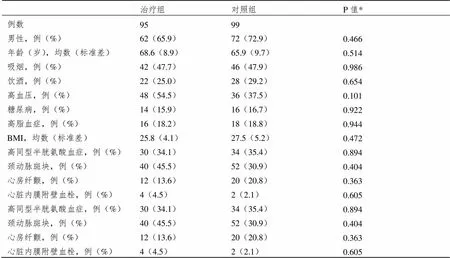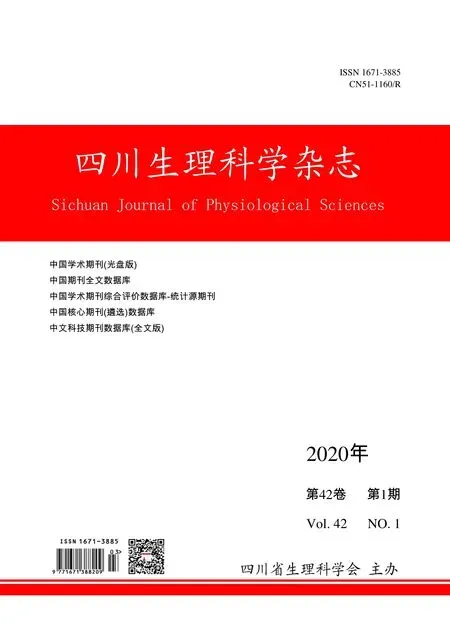根除幽门螺杆菌治疗对TIA患者同型半胱氨酸及其预后的影响
赵琳琳 陈玉婷 徐涛 张文广
·临床论著·
根除幽门螺杆菌治疗对TIA患者同型半胱氨酸及其预后的影响
赵琳琳*1陈玉婷2徐涛3张文广∆4
(1. 重庆市巴南区人民医院老年科,重庆 401320;2. 昆明医科大学附属昭通医院脑血管科,云南 昭通 657000;3. 昆明医科大学附属昭通医院消化内科,云南 昭通 657000;4. 重庆市巴南区人民医院消化内科,重庆 401320)
探讨根除幽门螺杆菌(,Hp)治疗对短暂性脑缺血发作(Transient ischemic attack,TIA)患者同型半胱氨酸(Homocysteine,Hcy)及其预后的影响。选取2013年8月至2017年6月期间两家医院收治的首次发作TIA患者共计396例,常规进行尿素酶试验,将尿素酶试验阳性的TIA患者204例随机分为治疗组(n=102)和对照组(n=102),所有患者均给予常规药物治疗,其中治疗组患者在此基础上予以根除Hp治疗。动态观察2组治疗前、治疗后1 m,6 m,12 m Hcy变化,随访2组患者在半年,1年,2年内脑梗塞发生率。TIA患者根除Hp治疗后血清同型半胱氨酸显著降低(P<0.05),根除Hp后患者随时间延长血清同型半胱氨酸下降越明显(P<0.05)。治疗组和对照组TIA患者半年内脑梗死发生率无明显统计学差异(P>0.05),而治疗组TIA患者1年及2年内脑梗塞发生率较对照组显著降低(P<0.05),但1年内脑梗塞发生率与2年内脑梗塞发生率无明显差异(P>0.05)。幽门螺杆菌感染可能是脑卒中的危险因素;积极抗幽门螺杆菌感染治疗,可显著降低脑梗塞的发生,并可降低同型半胱氨酸水平,预防TIA进展为脑梗塞有一定的临床价值。
幽门螺杆菌;短暂性脑缺血发作;同型半胱氨酸
脑卒中为我国国民主要死亡原因,其中缺血性脑卒中占43%~79%[1]。据统计,在缺血性脑卒中患者中,新发TIA患者每年超过200万。由于TIA发病后2 d内为卒中再发的高风险期,并且TIA后7 d 内具有4%~10%的卒中再发风险,90 d内具有8%~12%的卒中再发风险,TIA具有高发病率、高致残率及高复发率等特点,也是成年人致残的主要病因[2-4]。
近年研究发现,脑梗死的危险因素除高血压、高血糖、高血脂、吸烟等外,一些急慢性炎症也可影响动脉粥样硬化而发生脑梗死[5-7]。流行病学研究发现,幽门螺杆菌(,Hp)感染与脑梗死存在一定的相关性,其主要作用机制可能是通过诱导免疫-炎症反应促进动脉粥样硬化[5-8]。也有研究显示Hp感染还可能干扰血清同型半胱氨酸(Homocysteine,Hcy)代谢,影响脑梗死的发生[9]。而根除HP治疗后是否可以在一定程度上防止TIA进展为脑梗塞,目前国内外少有前瞻性研究。
本研究拟对我院的收治的TIA患者常规做尿素酶试验,将尿素酶试验阳性的TIA患者随机分为治疗组和对照组,治疗组患者加用抗幽门螺杆菌治疗,动态观察2组患者治疗前、治疗后1月,6月,12月Hcy变化,随访2组患者在半年、1年、2年内脑梗塞发生率。
1 资料与方法
1.1 临床资料
2013年8月至2017年6月在昆明医科大学附属昭通医院脑血管内科及巴南区人民医院老年科住院的首次发作TIA患者396例,常规做尿素酶试验,采用深圳海德威生物科技有限公司HTY1001 Hp测试仪及碳[14C]尿素呼气试验(Urea breath test,UBT)药盒测定。结果[14C]UBT≥100 dpm•mmol-1CO2为阳性。其中尿素酶试验阳性患者204例,占总数的51.5%,其中男138例,女66例,年龄61.51±5.57岁。
纳入标准:①符合美国卒中协会TIA标准[10];②症状恢复完全,不遗留任何神经功能缺失体征;③头颅CT /MRI证实无颅内出血、颅内占位及可解释患者症状的定位责任病灶。
排除标准:①DWI显示存在急性脑梗死责任病灶;②既往有脑梗塞病灶;③由于非血管性疾病所致的肢体无力或言语障碍等其他非TIA疾病;④Hp外的其他因素(如严重的心肝肾疾病、合并感染及近期应用抗生素等)所致炎症;⑤颈动脉彩色超声检查发现颈动脉斑块伴狭窄≥50%;⑥既往有严重心、肺、肝或肾脏功能不全病史。
所有患者均通过昭通市第一人民医院及巴南区人民医院医学伦理委员会批准并获得患者及家属的知情同意及签署知情同意书。
1.2 方法
204例尿素酶实验阳性患者采用计算机随机抽样分组分为治疗组和对照组(n=102)。两组患者均给予为期2 w的TIA常规治疗(抗凝、抗血小板聚积、改善脑供血供氧、调整血压等)。而治疗组患者在此基础上加用奥美拉唑20 mg,阿莫西林胶囊1.0 g,克拉霉素片0.5 g,每日2次口服,治疗10 d。1m后复查尿素酶试验,如果结果阳性,判定为HP根除失败,予以退出本研究。
入院后治疗前及治疗后1 m、6 m、12 m抽取患者空腹血测定血清同型半胱氨酸水平。出院后随访半年、1年、2年,计算初发脑梗塞和复发性脑梗塞。复发性脑梗塞的诊断标准[11-12]:①患者原有初发症状和体征加重,距离第一次梗塞时间大于1月;②出现新的神经系统功能缺损症状;③经头颅CT或MRI证实有新发病灶或另外血管分布区病灶。
1.3 统计学方法
应用SPSS 20.0 统计软件,对于计量资料,检验其分布形态和方差齐性,若属对称分布,采用均数±标准差进行统计描述,否则采用中位数(四分位间距)M(IQR)描述其集中和离散趋势。治疗前及治疗后血清Hcy变化比较采用重复测量方差分析。对不符合正态分布的资料进行秩和检验。两组患者卒中发生率比较采用卡方检验或者Fisher确切概率法。P<0.05为差异有统计学意义。
2 结果
2.1 基线资料比较
治疗组有5例患者HP根除失败,退出研究。治疗组患者Hp根除率为91.7%。治疗组失访2例,对照组失访3例。两组患者在年龄、性别、吸烟、饮酒及高血压、糖尿病、高脂血症、血清同型半胱氨酸等指标差异均无统计学意义(P>0.05),具有可比性,见表1。

表1 治疗组与对照组基线资料比较
注:*表示计数资料比较时采用卡方检验,计量资料比较时采用独样本检验
2.2 两组患者治疗前后同型半胱氨酸变化
本研究结果显示:F分组=14.673,P分组=0.032,TIA患者根除Hp 后血清同型半胱氨酸显著降低;F时间=21.782,P时间=0.014,根除HP后患者随时间延长血清同型半胱氨酸下降越明显;F分组×时间=3.786,P分组×时间=0.10,分组效应和时间无交互作用。Hp感染阳性TIA患者根除Hp治疗后患者血清同型半胱氨酸显著下降,见表2。
2.3 Hp根除后对TIA患者脑梗塞发病率的影响。
表3显示,治疗组和对照组TIA患者半年内脑梗塞发生率无明显统计学差异(P>0.05);治疗组HP阳性TIA患者1年内脑梗塞发生率较对照组显著降低(P<0.05);2年内脑梗塞发生率较对照组显著降低(P<0.05)。
3 讨论
TIA被公认为缺血性脑卒中最重要的危险因素,是成年人致残的主要病因[2-4]。TIA发病后2 d内为卒中再发的高风险期,并且TIA后7 d内具有4%~10%的卒中再发风险,90 d内具有8%~12%的卒中再发风险。
Sebastián等在20例颈动脉斑块中检测到Hp DNA,提示Hp感染与动脉粥样硬化相关[13]。近年多数流行病学资料显示,Hp感染与脑卒中的发生、发展存在一定的相关性[9]。
有研究报道根除HP治疗后可降低脑梗死病人再次住院率[14]。本研究结果也证明幽门螺杆菌感染可能是脑卒中的危险因素且根除HP治疗可有效预防脑梗死的发生,根除Hp治疗后的TIA患者1年、2年脑梗塞发生率较对照组显著降低,表明根除Hp治疗可有效预防TIA进展为脑梗塞。但根除HP治疗后的TIA患者半年内卒中发生率与对照组之间无明显统计学差异,这可能与本研究观察样本量较少及观察时间较短有关,需要进一步增大样本量观察。

表2 治疗前和治疗后1,6,12和24月治疗组与对照组患者同型半胱氨酸变化(±SD)
注:与对照组相比,*P<0.05。

表3 治疗组与对照组患者半年、1年及2年内脑卒中发生率比较(例(%))
注:与对照组比较,*P<0.05。
高同型半胱氨酸血症是目前比较公认的脑梗死的危险因素[15]。Hcy在体内的代谢必须依赖于B族维生(VitB12、VitB6、VitB2)和几种酶的参与,当这些维生素缺乏时,将引起Hcy的代谢障碍,导致高Hcy[15]。
Tamura等[16]发现Hp感染通过影响叶酸和维生素B12的吸收使血同型半胱氨酸水平升高从而促进动脉粥样硬化。吴海琴等[9]研究发现Hp感染与脑梗死发病相关,可能是脑梗死的危险因素且进一步发现CagA阳性Hp感染可能通过升高血Hcy水平而增加脑梗死。本研究还发现根除HP后TIA患者血清同型半胱氨酸较对照组显著降低且随时间延长血清同型半胱氨酸下降越明显,表明根除HP治疗后可能通过下调血清同型半胱氨酸水平而降低脑血管事件发生风险,而其确切独立相关性及具体机制需深入基础研究。
综上所述,有效根除Hp治疗可以降低TIA进展为脑梗塞风险,且可能通过下调血清Hcy水平改善动脉粥样硬化斑块形成,降低脑卒中的发生。因此,有效根除Hp治疗对预防TIA进展为脑梗塞发生有重要的临床价值,可作为脑血管事件的二级预防措施。
1 Jackson SP. Arterial thrombosis--insidious, unpredic- table and deadly[J]. Nat Med, 2011, 17(11): 1423-1436.
2 Liu L, Wang D, Wong KS, et al. Stroke and stroke care in China: huge burden, significant workload, and a national priority[J]. Stroke, 2011, 42(12): 3651-3654.
3 Wasserman J, Perry J, Dowlatshahi D, et al. Stratified, urgent care for transient ischemic attack results in low stroke rates[J]. Stroke, 2010, 41(11): 2601-2605.
4 Wang YJ, Zhang SM, Zhang L, et al. Chinese guidelines for the secondary prevention of ischemic stroke and transient ischemic attack 2010[J]. CNS Neurosci Ther, 2012, 18(2): 93-101.
5 Alvarez-Arellano L, Maldonado-Bernal C.and neurological diseases: Married by the laws of inflammation[J]. World J Gastrointest Pathophysiol, 2014, 5(4): 400-404.
6 Huang WS, Tseng CH, LIN CL, et al.infection increases subsequent ischemic stroke risk: a nationwide population-based retrospective cohort study[J]. QJM, 2014, 107(12): 969-975.
7 Yu M, Zhang Y, Yang Z, et al. Association betweeninfection and stroke: a meta-analysis of prospective observational studies[J]. J Stroke Cerebrovasc Dis, 2014, 23(9): 2233-2239.
8 Jang SH, Lee H, Kim JS, et al. Association betweeninfection and cerebral small vessel disease[J]. Korean J Fam Med, 2015, 36(5): 227-232.
9 吴海琴, 张欣, 汤燕, 等. 幽门螺杆菌感染与脑梗死患者同型半胱氨酸的关系[J]. 浙江大学学报(医学版), 2012, 41(1):89-92.
10 Easton JD, Saver JL, Albers GW, et al. Definition and evaluation of transient ischemic attack: a scientific statement for healthcare professionals from the American Heart Association/American Stroke Association Stroke Council; Council on Cardiovascular Surgery and Anesthesia; Council on Cardiovascular Radiology and Intervention; Council on Cardiovascular Nursing; and the Interdisciplinary Council on Peripheral Vascular Disease. The American Academy of Neurology affirms the value of this statement as an educational tool for neurologists[J]. Stroke, 2009, 40(6): 2276-2293.
11 Sarti C, Stegmayr B, Tolonen H, et al. Are changes in mortality from stroke caused by changes in stroke event rates or case fatality? Results from the WHO MONICA Project[J]. Stroke, 2003, 34(8): 1833-1840.
12 Bonita R, Anderson CS, Broad JB, et al. Stroke incidence and case fatality in Australasia. A comparison of the Auckland and Perth population-based stroke registers[J]. Stroke, 1994, 25(3): 552-557.
13 Ameriso SF, Fridman EA, Leiguarda RC, et al. Detection of Helicobacter pylori in human carotid atherosclerotic plaques[J]. Stroke, 2001, 32(2): 385-391.
14 潘桂群. 抗幽门螺杆菌治疗对急性脑梗死患者预后的影响[J]. 中南大学学报(医学版), 2011, 36(9): 872-5.
15 Han L, Wu Q, Wang C, et al. Homocysteine, ischemic stroke, and coronary heart disease in hypertensive patients: a population-based, prospective cohort study[J]. Stroke, 2015, 46(7): 1777-1786.
16 Tamura A, Fujioka T, Nasu M. Relation ofinfection to plasma vitamin B12, folic acid, and homocysteine levels in patients who underwent diagnostic coronary arteriography[J]. Am J Gastro- enterol, 2002, 97(4): 861-866.
eradication therapy on homocysteine and its prognosis of patients with TIA
Zhao Lin-lin*1, Chen Yu-ting2, Xu Tao3, Zhang Wen-guang∆4,
(1. Department of Geriatrics, The People's Hospital of Banan District, Chongqing 401320; 2. Department of Vasculocardiology, The Affiliated Hospital at Zhaotong of Kunming Medical University, Zhaotong 657000, Yunnan; 3. Department of Gastroenterology, The Affiliated Hospital at Zhaotong of Kunming Medical University, Zhaotong 657000, Yunnan; 4. Department of Gastroenterology, The People's Hospital of Banan District, Chongqing 401320)
To investigates the effect oferadication therapy on homocysteine (HCY) and its prognosis of patients with transient ischemic attack (TIA).From August 2013 to June 2017, 396 patients with first TIA in two hospitals were selected for routine urease test. 204 TIA patients with positive urease test were randomly divided into treatment group (n=102) and control group (n=102). All patients were given routine drug treatment, on the basis of which the patients in the treatment group were given HP eradication treatment. The changes of Hcy were observed before and after treatment, and the incidence of cerebral infarction was followed up for half a year, one year and two years.The serum homocysteine in patients with TIA decreased significantly after Hp eradication (P<0.05), and the more significant the decrease of serum homocysteine was with time prolongation (P<0.05). There was no significant difference in the incidence of cerebral infarction within half a year between the treatment group and the control group (P>0.05), while the incidence of cerebral infarction within one year and two years in the treatment group was significantly lower than that in the control group (P<0.05), but there was no significant difference between the incidence of cerebral infarction within one year and that within two years in the treatment group (P>0.05).Helicobacter pylori infection may be a risk factor for stroke. Active treatment ofinfection can significantly reduce the occurrence of stroke and lower homocysteine levels, and it has certain clinical values to prevent TIA from developing into cerebrovascular.
; Transient ischemic attack; Homocysteine
Intersection of biology and therapeutics: type 2 targeted therapeutics for adult asthma.
Peters MC, Wenzel SE
Asthma is a disease of reversible airflow obstruction characterised clinically by wheezing, shortness of breath, and coughing. Increases in airway type 2 cytokine activity, including interleukin-4 (IL-4), IL-5, and IL-13, are now established biological mechanisms in asthma. Inhaled corticosteroids have been the foundation for asthma treatment, in a large part because they decrease airway type 2 inflammation. However, inhaled or systemic corticosteroids are ineffective treatments in many patients with asthma and few treatment options exist for patients with steroid resistant asthma. Although mechanisms for corticosteroid refractory asthma are likely to be numerous, the development of a new class of biologic agents that target airway type 2 inflammation has provided a new model for treating some patients with corticosteroid refractory asthma. The objective of this Therapeutic paper is to summarise the new type 2 therapeutics, with an emphasis on the biological rationale and clinical efficacy of this new class of asthma therapeutics.
(From Lancet, 2020, 395(10221): 371-383.)
(2019-10-26)
赵琳琳,女,主治医师,主要从事脑血管疾病的基础与临床研究,Email:25776589@qq.com;
张文广,男,主治医生,主要从事,Email: zhang-wenguang@163.com。

